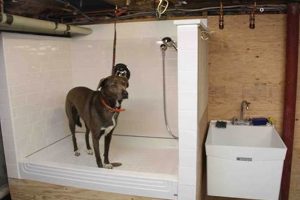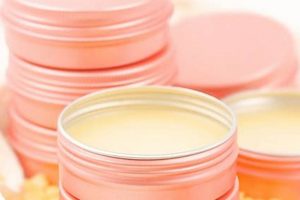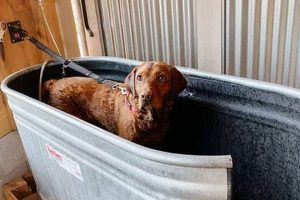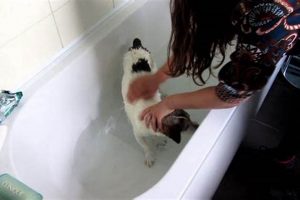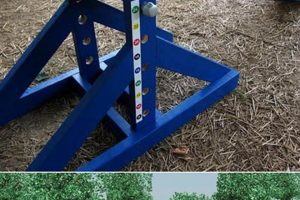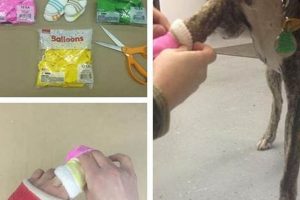The creation of canine apparel at home involves designing and constructing garments specifically tailored for dogs, utilizing readily available materials and tools. This encompasses a broad range of items, from basic sweaters and coats for warmth to decorative costumes and accessories. As an example, an individual might fashion a fleece vest for their pet using a repurposed blanket and simple sewing techniques.
Engaging in the practice offers several advantages. It provides a cost-effective alternative to purchasing commercially produced items, allowing owners to personalize their pet’s wardrobe to suit individual needs and preferences. Furthermore, this activity fosters creativity and resourcefulness, contributing to a sense of accomplishment. Historically, homemade pet attire served primarily a practical function, providing protection from the elements before evolving into a form of self-expression.
The following sections will delve into the materials commonly used in the creation of these items, outline basic construction techniques, and explore potential design considerations for maximizing comfort and functionality for the animal.
Essential Considerations for Canine Garment Creation
Successful production of apparel for dogs requires careful attention to detail and a focus on both aesthetics and functionality. The following guidelines are presented to optimize the creation process and ensure the comfort and well-being of the animal.
Tip 1: Prioritize Comfort and Safety: Garments should not restrict movement or cause irritation. Select soft, breathable fabrics and avoid embellishments that could pose a choking hazard.
Tip 2: Accurate Measurements are Crucial: Precise measurements of the dog’s neck, chest, and back length are essential for a proper fit. A garment that is too tight can restrict breathing and movement, while one that is too loose can be a tripping hazard.
Tip 3: Fabric Selection Impacts Functionality: Choose fabrics appropriate for the intended use. For warmth, fleece or wool are suitable options. For rain protection, consider waterproof or water-resistant materials. Consider the breathability of the material to prevent overheating.
Tip 4: Seam Placement Matters: Place seams strategically to minimize chafing and irritation. Consider using flat-felled seams or serging raw edges to prevent fraying and create a smoother finish.
Tip 5: Closure Mechanisms Must Be Secure: Utilize closures such as Velcro, snaps, or zippers that are both secure and easy to use. Ensure that closures do not pinch or pull on the dog’s fur or skin.
Tip 6: Consider the Dog’s Breed and Coat: Different breeds and coat types may require specific design adaptations. For example, dogs with long fur may benefit from designs that minimize matting, while short-haired breeds may require extra insulation in colder climates.
Tip 7: Regular Inspection is Essential: Routinely inspect garments for signs of wear and tear, such as loose seams or damaged closures. Repair or replace items as needed to maintain safety and functionality.
Adhering to these considerations will increase the likelihood of creating comfortable, safe, and functional apparel for canine companions. Proper planning and execution contribute to a positive experience for both the creator and the dog.
The subsequent sections will explore advanced design techniques and customization options, enabling the creation of unique and personalized items.
1. Fabric Selection
Fabric selection exerts a direct influence on the functionality, comfort, and longevity of homemade canine apparel. The material chosen determines the garment’s suitability for different weather conditions, its ease of care, and its overall impact on the animal’s well-being. For instance, using a tightly woven cotton fabric for a summer dress allows for breathability, minimizing the risk of overheating. Conversely, selecting a water-resistant nylon fabric for a rain jacket provides protection from moisture, keeping the dog dry and comfortable. Inappropriate fabric choices can lead to discomfort, skin irritation, or even overheating, negating the intended benefits of the garment. Therefore, fabric selection is not merely an aesthetic consideration but a critical component in creating effective and safe canine clothing.
The practical implications of fabric choice extend to the garment’s durability and ease of maintenance. A robust fabric like denim or canvas, while potentially heavier, can withstand more wear and tear, making it suitable for active dogs. In contrast, delicate fabrics such as silk or lace, while visually appealing, may be more prone to damage and require more careful handling. Furthermore, the ease with which a fabric can be cleaned is a practical concern. Fabrics that are machine washable and resistant to shrinking or fading simplify the garment’s upkeep, making it a more convenient option for everyday wear. Consider, for instance, the difference in care requirements between a fleece sweater that can be easily laundered and a hand-knitted wool coat that requires specialized cleaning.
In summary, careful consideration of fabric properties is paramount when creating canine apparel. The choice of material directly affects the garment’s performance, comfort, and ease of maintenance, contributing significantly to the overall success of the project. While aesthetic preferences play a role, prioritizing functionality and practicality will ensure that the resulting garment meets the needs of the dog and its owner. Overlooking this crucial aspect can result in a garment that is uncomfortable, impractical, or even unsafe for the animal, highlighting the importance of informed fabric selection in the creation of custom canine clothing.
2. Accurate Measurement
The precise acquisition of canine body dimensions is paramount to the successful creation of homemade garments. Imprecise measurements result in ill-fitting apparel, negating the benefits of custom-made items and potentially causing discomfort or even harm to the animal. Therefore, rigorous measurement techniques are a foundational element of crafting canine clothing.
- Neck Circumference
The measurement of the neck’s circumference directly impacts the comfort and security of collars, sweaters, and other upper-body garments. An overly tight neck opening restricts breathing and movement, while a loose fit allows the garment to slip off easily. For example, if a dog’s neck measures 16 inches, the pattern must account for this dimension plus a small allowance for comfort and ease of movement. Ignoring this step leads to garments that are either unwearable or unsafe.
- Chest Girth
Chest girth, measured at the widest point behind the front legs, determines the overall fit of the body of the garment. An inaccurate chest measurement results in a garment that is either too restrictive, limiting the dogs range of motion, or too loose, potentially snagging on objects during activity. As an illustration, a measurement discrepancy of even one inch can significantly alter the garment’s fit, leading to discomfort and reduced functionality. Correct chest measurements are essential for creating well-fitting coats, vests, and dresses.
- Back Length
Back length, extending from the base of the neck to the base of the tail, dictates the overall length of the garment. If the back length is underestimated, the garment may fail to provide adequate coverage, leaving portions of the animal’s body exposed to the elements. Conversely, an overestimated back length can result in a garment that interferes with the dog’s tail movement or creates a tripping hazard. For instance, if a dog’s back length is 18 inches, the garment should be designed accordingly, with adjustments made based on the garment’s style and intended use.
- Leg Length (Where Applicable)
For garments that incorporate leg coverings, such as full-body suits or pajama-style outfits, accurate leg length measurements are essential. Incorrect leg lengths can cause chafing, restrict movement, or pose a tripping hazard. When measuring leg length, it is important to account for the dog’s posture and natural gait. For example, measurements should be taken while the dog is standing in a natural, relaxed position to ensure an accurate fit. Failure to accurately measure leg length can significantly impact the dog’s comfort and mobility.
The cumulative impact of these individual measurements underscores the importance of precision in creating canine apparel. Each dimension contributes to the overall fit and functionality of the garment. Overlooking or underestimating any measurement increases the likelihood of creating a garment that is uncomfortable, unsafe, or impractical for the intended purpose. The commitment to accurate measurement is thus a fundamental prerequisite for successful homemade dog clothing.
3. Seam Construction
Seam construction is a critical determinant of the durability, comfort, and aesthetic quality of homemade canine apparel. The method used to join fabric pieces directly affects the garment’s ability to withstand stress, prevent fraying, and minimize irritation to the animal’s skin. For instance, a poorly constructed seam, such as one with insufficient seam allowance or a weak stitch type, is prone to unraveling, rendering the garment unusable after minimal wear. Conversely, a well-executed seam, utilizing a reinforced stitch and appropriate seam finish, enhances the garment’s longevity and overall value. The selection of a suitable seam construction technique is therefore integral to the creation of functional and lasting “diy dog clothes”.
The practical significance of effective seam construction extends to the animal’s comfort and safety. Raw edges of fabric, if left exposed, can cause chafing and skin irritation, particularly in dogs with sensitive skin. Techniques such as serging or binding these edges are essential for preventing discomfort. Furthermore, the placement of seams can also impact comfort; seams positioned in areas of high friction, such as under the arms or along the belly, should be minimized or carefully constructed to avoid irritation. For example, flat-felled seams, which encase the raw edges of the fabric, provide a smooth, durable finish that minimizes the risk of chafing. Understanding and applying appropriate seam construction methods is thus crucial for ensuring the well-being of the animal.
In summary, seam construction is an indispensable aspect of crafting “diy dog clothes”. The selection of appropriate techniques directly influences the garment’s durability, comfort, and aesthetic appeal. Challenges in seam construction often stem from a lack of knowledge regarding different seam types and their suitability for specific fabrics and applications. However, by prioritizing proper seam construction techniques, creators can enhance the quality and longevity of their homemade canine apparel, ensuring both the animal’s comfort and the garment’s lasting value. The effective execution of this element reflects a commitment to producing functional and aesthetically pleasing items.
4. Closure Security
The efficacy of closure mechanisms in homemade canine apparel is inextricably linked to the garment’s functionality and the animal’s safety. Insecure closures represent a direct cause of garment failure, leading to potential hazards for the dog. If closures, such as buttons, snaps, or hook-and-loop fasteners, fail to remain securely fastened, the garment may loosen, increasing the risk of entanglement in the environment. Moreover, ingestion of detached closures poses a significant choking hazard. Therefore, ensuring closure security is paramount in the creation of durable and safe “diy dog clothes”. For example, a poorly attached button on a dog coat can detach during activity, posing a risk of ingestion or entanglement, thus rendering the entire garment unsafe despite other positive attributes.
Selection of appropriate closure types is a critical factor. Hook-and-loop fasteners, while convenient, may lose their grip over time or become clogged with fur, diminishing their effectiveness. Snaps and buttons, while more secure when properly attached, require careful reinforcement to prevent detachment due to the forces exerted during canine movement. Zippers offer a more robust closure option, but their placement and design must prioritize the dog’s comfort, avoiding pinching or chafing. Furthermore, the attachment method is equally important. Reinforcing seams with multiple rows of stitching or utilizing specialized tools, such as snap pliers, significantly enhances the security of closures. Practical application involves selecting closures appropriate for the garment’s design and the dog’s activity level, combined with careful attachment techniques.
In conclusion, the security of closures represents a fundamental aspect of homemade canine apparel, directly impacting the garment’s functionality and the animal’s well-being. Selection of appropriate closure types, combined with meticulous attachment techniques, mitigates the risk of garment failure and potential hazards. While aesthetic considerations are relevant, prioritizing closure security ensures that “diy dog clothes” fulfill their intended purpose safely and effectively. Overlooking this critical detail undermines the value of the entire project and compromises the animal’s safety.
5. Comfort Focus
The central tenet guiding the design and construction of homemade canine apparel lies in prioritizing the animal’s comfort. This principle transcends mere aesthetic considerations, dictating material selection, garment fit, and overall design choices. Garments designed without sufficient attention to comfort can cause distress, restrict movement, and potentially lead to physical harm. Thus, a focus on comfort is paramount in the creation of functional and humane “diy dog clothes”.
- Material Breathability and Texture
Fabric selection profoundly impacts comfort. Materials lacking breathability, such as non-porous synthetics, can trap heat and moisture, leading to overheating and skin irritation. Rough or abrasive textures can cause chafing, particularly in areas of high friction, such as under the legs or around the neck. Cotton, linen, and fleece are often favored for their breathability and soft texture. Practical application includes selecting lightweight, breathable fabrics for warm-weather garments and opting for soft, non-irritating materials for sensitive-skinned breeds. The avoidance of harsh dyes and chemical treatments further contributes to comfort. For example, a fleece vest should be preferred over a wool one for breeds susceptible to allergic skin reactions.
- Freedom of Movement
Garments should not impede the dog’s natural range of motion. Restrictive designs can cause discomfort and limit the animal’s ability to perform essential activities, such as walking, running, and toileting. Proper pattern design is crucial, accounting for the dog’s anatomy and allowing for adequate ease of movement. Sleeves should be appropriately sized, and the garment’s length should not interfere with the tail or hind legs. A garment that is too tight across the chest or shoulders can restrict breathing and cause discomfort. Ensuring freedom of movement is essential for promoting the animal’s well-being. Consider the design implications; a tight sweater may restrict running and jumping.
- Seam Placement and Finish
Seam construction profoundly impacts comfort. Poorly placed seams, particularly those that rub against the skin, can cause irritation and chafing. Seams should be positioned away from areas of high friction and finished to eliminate raw edges. Techniques such as serging or binding seam allowances provide a smooth, comfortable finish. Flat-felled seams, which encase raw edges, are particularly well-suited for garments designed for active wear. Reinforcing seams in high-stress areas enhances durability without compromising comfort. Consider the discomfort a poorly placed seam can cause after long walks.
- Elimination of Irritants
Garments should be free from potentially irritating elements, such as loose threads, sharp edges, or abrasive closures. Embellishments, such as buttons or beads, should be securely attached to prevent detachment and potential ingestion. Closures, such as zippers or snaps, should be carefully positioned to avoid pinching or pulling on the dog’s fur or skin. Labels and tags should be made of soft materials and placed away from sensitive areas. A thorough inspection of the finished garment is essential to identify and eliminate any potential irritants. The avoidance of harsh detergents or fabric softeners further contributes to comfort. Always trim loose threads to prevent entanglement or ingestion.
These facets highlight the importance of comfort in “diy dog clothes”. Material choice, freedom of movement, proper seam construction, and eliminating irritants are crucial considerations. Creating garments that prioritize comfort ensures that the animal experiences a positive wearing experience. Without a comfort focus, even well-intentioned “diy dog clothes” can cause discomfort and harm, negating the benefits of homemade items.
6. Durability Needs
The resilience of homemade canine apparel is a critical consideration, directly influencing its longevity and cost-effectiveness. Garments lacking adequate durability are prone to rapid deterioration, requiring frequent replacement and negating the economic and environmental benefits of “diy dog clothes”. Understanding the factors contributing to durability is therefore essential for creating lasting and functional items.
- Fabric Strength and Resistance to Abrasion
The inherent strength of the fabric and its ability to withstand abrasion are primary determinants of garment longevity. Fabrics such as tightly woven canvas, denim, or ripstop nylon offer superior resistance to tearing and wear compared to more delicate materials like silk or loosely woven cotton. For example, a coat constructed from heavy-duty canvas will withstand significantly more wear and tear during outdoor activities than one made from lightweight cotton. Selecting fabrics appropriate for the intended use directly contributes to the garment’s lifespan.
- Seam Strength and Integrity
The robustness of the seams joining fabric pieces is crucial for preventing garment failure. Weak seams are prone to unraveling under stress, rendering the garment unusable. Reinforced seams, utilizing a durable stitch type and sufficient seam allowance, enhance the garment’s ability to withstand repeated use and laundering. For instance, a flat-felled seam, which encases raw edges and provides a double layer of stitching, offers superior strength and resistance to fraying compared to a simple serged seam. Employing appropriate seam construction techniques is essential for maximizing durability.
- Hardware Quality and Attachment
Closures, such as zippers, snaps, and buckles, must be of sufficient quality and securely attached to ensure the garment remains functional. Inferior hardware is prone to breakage, rendering the garment unusable even if the fabric and seams remain intact. Secure attachment methods, such as reinforcing seams with multiple rows of stitching or using specialized tools, are essential for preventing hardware detachment. A high-quality metal zipper, for example, will withstand significantly more stress than a flimsy plastic one. Selecting durable hardware and employing robust attachment techniques contributes to the garment’s overall lifespan.
- Resistance to Environmental Factors
The garment’s ability to withstand exposure to environmental elements, such as sunlight, moisture, and chemicals, also influences its durability. Fabrics that are resistant to fading, water damage, and chemical degradation will maintain their integrity over time. For example, a coat constructed from UV-resistant fabric will withstand significantly more exposure to sunlight without fading or degrading than one made from untreated cotton. Selecting fabrics with appropriate resistance to environmental factors extends the garment’s lifespan and maintains its aesthetic appeal.
These considerations are instrumental for a durable “diy dog clothes”. Careful fabric selection, seam construction, hardware selection, and attention to environmental resistance contributes to the overall resilience and extends the usability. Neglecting durability needs will result in garments that quickly deteriorate, negating the benefits of homemade creation.
7. Design Suitability
The concept of design suitability, within the context of homemade canine apparel, encompasses the careful tailoring of garment features to align with the specific needs, characteristics, and lifestyle of the individual dog. It represents a critical departure from mass-produced items, which often fail to account for the diverse range of canine breeds, sizes, and temperaments. Design suitability is therefore a cornerstone of effective and humane “diy dog clothes” creation.
- Breed-Specific Anatomical Considerations
Different canine breeds exhibit distinct anatomical variations that necessitate tailored garment designs. For example, brachycephalic breeds (e.g., Pugs, Bulldogs) require neck openings that accommodate their compressed facial structure, preventing constriction and breathing difficulties. Long-bodied breeds (e.g., Dachshunds) benefit from garments that provide adequate back coverage and support. Recognizing and accommodating these breed-specific anatomical nuances is essential for ensuring a comfortable and functional fit.
- Adaptation to Climate and Environment
Garment design must align with the prevailing climate and environmental conditions. Dogs residing in cold climates require insulated garments that provide adequate warmth. Conversely, dogs living in warm climates benefit from lightweight, breathable apparel that protects against sun exposure without causing overheating. For example, a waterproof coat with a fleece lining is suitable for dogs in rainy, cold environments, while a light-colored cotton shirt offers sun protection in hot, sunny conditions. Adapting design to climate ensures canine comfort and well-being.
- Accommodation of Activity Level and Lifestyle
A dog’s activity level and lifestyle significantly influence garment design requirements. Active dogs engaged in outdoor pursuits benefit from durable, abrasion-resistant apparel that can withstand wear and tear. Conversely, less active dogs may require more delicate, comfortable garments for indoor use. The design must also accommodate specific activities, such as swimming or hiking. For instance, a life vest for dogs participating in water activities requires buoyant materials and secure closures. Adjusting design to dog’s lifestyle assures effective garment performance.
- Consideration of Individual Needs and Health Conditions
The design must accommodate individual needs and health conditions. Dogs with mobility issues may require garments that facilitate movement and provide support. Dogs with skin allergies or sensitivities benefit from apparel constructed from hypoallergenic materials. Moreover, garments can be adapted to accommodate medical devices, such as IV lines or bandages. Attending to individual requirements increases garment utility and quality of life.
The aforementioned facets highlights design suitability as a cornerstone of “diy dog clothes” creation. Addressing these four factors increases the likelihood of success. Failing to consider these aspects undermines potential benefits. Creating garments that enhance canine welfare and comfort is an advantage of “diy dog clothes”.
Frequently Asked Questions
The following section addresses common inquiries and misconceptions surrounding the creation and utilization of homemade garments for dogs. The information provided aims to offer clarity and guidance based on established best practices.
Question 1: What materials are most suitable for creating canine clothing, and why?
Fabrics like cotton, fleece, and certain synthetic blends (e.g., water-resistant nylon) are frequently employed. Cotton offers breathability and comfort, making it suitable for warmer climates. Fleece provides insulation for colder conditions. Water-resistant nylon protects against moisture. Material selection should prioritize comfort, safety, and intended use.
Question 2: How should measurements be accurately obtained to ensure proper garment fit?
Accurate measurements require a flexible measuring tape and a cooperative canine subject. Key measurements include neck circumference, chest girth, back length, and, if applicable, leg length. The dog should be standing squarely during measurement. A small allowance (1-2 inches) should be added to measurements for comfort and ease of movement.
Question 3: What are the primary safety considerations when designing and constructing canine apparel?
Safety considerations include avoiding small, detachable embellishments that could pose a choking hazard, ensuring closures are secure and do not pinch or irritate the animal’s skin, and using non-toxic materials. Garments should not restrict movement or impede breathing. Regular inspection for wear and tear is essential.
Question 4: How can seam construction techniques enhance the durability and comfort of homemade canine clothing?
Employing durable seam construction techniques, such as flat-felled seams or serging raw edges, prevents fraying and enhances garment longevity. Placing seams strategically to minimize chafing and irritation is also crucial. A sufficient seam allowance (typically 1/2 inch) provides added strength and prevents unraveling.
Question 5: What are the potential benefits of creating custom canine garments compared to purchasing commercially produced items?
Custom creation allows for precise tailoring to fit the individual dog’s unique dimensions and needs. It provides greater control over material selection, ensuring the use of comfortable and safe fabrics. Customization also allows for the creation of designs that accommodate specific health conditions or mobility issues.
Question 6: How frequently should homemade canine apparel be laundered, and what cleaning methods are recommended?
Laundering frequency depends on the garment’s use and the dog’s activity level. Generally, washing garments every 1-2 weeks is advisable. Mild detergents and gentle washing cycles are recommended. Air drying is preferred to prevent shrinkage or damage to delicate fabrics. Heavily soiled garments may require pre-treatment.
Adhering to these guidelines promotes both functionality and security, enabling the creation of garments suitable for canine companions. Proper preparation facilitates good results.
The upcoming section will explore advanced design elements and personalization options for homemade items.
Conclusion
The preceding analysis has explored the multifaceted aspects of “diy dog clothes”, encompassing material selection, measurement techniques, seam construction, closure security, comfort considerations, durability requirements, and design suitability. These elements collectively determine the functionality, longevity, and overall value of homemade canine apparel. Prioritizing these considerations is essential for creating garments that enhance the animal’s well-being and meet the specific needs of individual dogs.
The commitment to crafting effective and humane “diy dog clothes” necessitates a dedication to informed decision-making and meticulous execution. Recognizing the interconnectedness of design elements and prioritizing both functionality and safety ensures that homemade creations represent a responsible and beneficial contribution to canine care. Further investigation into advanced design techniques and material innovations will continue to refine the possibilities within this field, ultimately benefiting canine companions.


